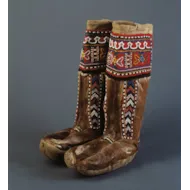A Pair of Athabascan North Western Canada Mukluks
A Pair of Athabascan North Western Canada Mukluks , caribou skin , red woolbroad cloth and glass beads . Lined with trade cloth
Late 19 th Century
Size : 38 cm high – 15 ins high
Late 19 th Century
Size : 38 cm high – 15 ins high
Mukluks are combined moccasins and leggings . These examples are made from the skin of caribou which together with the moose is the most important large food animal of the north west . The Athapascan , Tlingit and Eskimo peoples used the same materials to craft similar objects . The Eskimo were also influenced by those peoples of the Siberian arctic with whom they traded furs and other materials .
Following contact , the European fur trade was a pervasive influence among the regions native groups . From the 1600's to the late 1800's the establishment of trading posts transformed native culture in various ways . Access to European trade goods profoundly influenced material culture , with the groups who had firm contacts with the Hudson's Bay Company Trading Posts being the most affected .
With the coming of the missionaries in 1849 to the great slave lake and other areas it is almost certain that floral vestments , altar cloths and church paintings became the inspiration for new floral design motifs alongside the traditional double curve motif occurring in beadwork throughout the north western territories . By the 1850's the smaller type of bead , the glass seed bead was gaining favour and was used in a variety of colours with red and black trade cloth to embellish a wide variety of objects .
Athabascan beadwork of the late 19 th - early 20 th century provided a source of revenue for often impoverished families . Women made wall pockets , dog blankets , pouches , mittens , jackets , bags , boots and even shelf valences . All magnificently embellished with beads .
Following contact , the European fur trade was a pervasive influence among the regions native groups . From the 1600's to the late 1800's the establishment of trading posts transformed native culture in various ways . Access to European trade goods profoundly influenced material culture , with the groups who had firm contacts with the Hudson's Bay Company Trading Posts being the most affected .
With the coming of the missionaries in 1849 to the great slave lake and other areas it is almost certain that floral vestments , altar cloths and church paintings became the inspiration for new floral design motifs alongside the traditional double curve motif occurring in beadwork throughout the north western territories . By the 1850's the smaller type of bead , the glass seed bead was gaining favour and was used in a variety of colours with red and black trade cloth to embellish a wide variety of objects .
Athabascan beadwork of the late 19 th - early 20 th century provided a source of revenue for often impoverished families . Women made wall pockets , dog blankets , pouches , mittens , jackets , bags , boots and even shelf valences . All magnificently embellished with beads .
A Pair of Athabascan North Western Canada Mukluks

SOLD
YOU MAY ALSO LIKE

